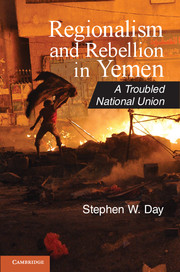Book contents
- Frontmatter
- Contents
- Tables
- Maps and Photos
- Preface
- Acknowledgments
- Abbreviations
- Chronology of Modern Yemeni History
- Glossary of Names of Key Political Figures
- Introduction
- 1 Understanding the Regional Divisions of Yemen
- 2 Two Revolutions, Two Republics
- 3 Salih Family Rules and the Sanhan Tribe
- 4 Unity in Name Only
- 5 The Spoils of Civil War
- 6 A Regime in Control?
- 7 Political Eruptions after 9/11
- 8 The Return of Yemeni Regionalism
- 9 Yemen’s Political Meltdown
- Conclusion
- Appendix
- Bibliography
- Index
2 - Two Revolutions, Two Republics
Published online by Cambridge University Press: 05 July 2012
- Frontmatter
- Contents
- Tables
- Maps and Photos
- Preface
- Acknowledgments
- Abbreviations
- Chronology of Modern Yemeni History
- Glossary of Names of Key Political Figures
- Introduction
- 1 Understanding the Regional Divisions of Yemen
- 2 Two Revolutions, Two Republics
- 3 Salih Family Rules and the Sanhan Tribe
- 4 Unity in Name Only
- 5 The Spoils of Civil War
- 6 A Regime in Control?
- 7 Political Eruptions after 9/11
- 8 The Return of Yemeni Regionalism
- 9 Yemen’s Political Meltdown
- Conclusion
- Appendix
- Bibliography
- Index
Summary
Yemen’s revolutions commenced slightly more than one year apart: September 1962 in the north, and October 1963 in the south. In both cases, the process of securing a new republican form of government extended through the late 1960s. The simultaneity of these revolutionary processes fostered greater national solidarities. Unionist sentiments rose on both sides of the border, as citizens in all regions felt pride in overturning their traditional rulers, and fighting to end British colonialism. As a result of these revolutionary activities, Yemenis also won a place of honor in the Arab world and among Third World countries. The experience was similar to what Egyptians went through after their national revolution in 1952, and what Algerians experienced following their long war for independence between 1954 and 1962.
Expectations of northern and southern unity soared in the mid-1960s when a prominent south Yemeni nationalist, Qahtan al-Shaabi (who eventually became the first president of independent south Yemen in 1967), was appointed cabinet minister in charge of the northern government’s unity affairs. Before the old border could be erased, however, each side faced the daunting task of unifying its own half of the country. Multiple regional divisions continued to shape northern and southern politics. Prior to independence in the south, the main political division was between two rival nationalist movements. The Front for the Liberation of South Yemen (FLOSY) was centered in Aden and backed by the government of Egypt. The National Liberation Front (NLF), a name later shortened to the National Front, was larger and more powerful with broad rural support among tribes in Aden’s hinterland, as well as migrants from north Yemen’s Shafi‘i areas in the western midlands.
- Type
- Chapter
- Information
- Regionalism and Rebellion in YemenA Troubled National Union, pp. 56 - 85Publisher: Cambridge University PressPrint publication year: 2012



